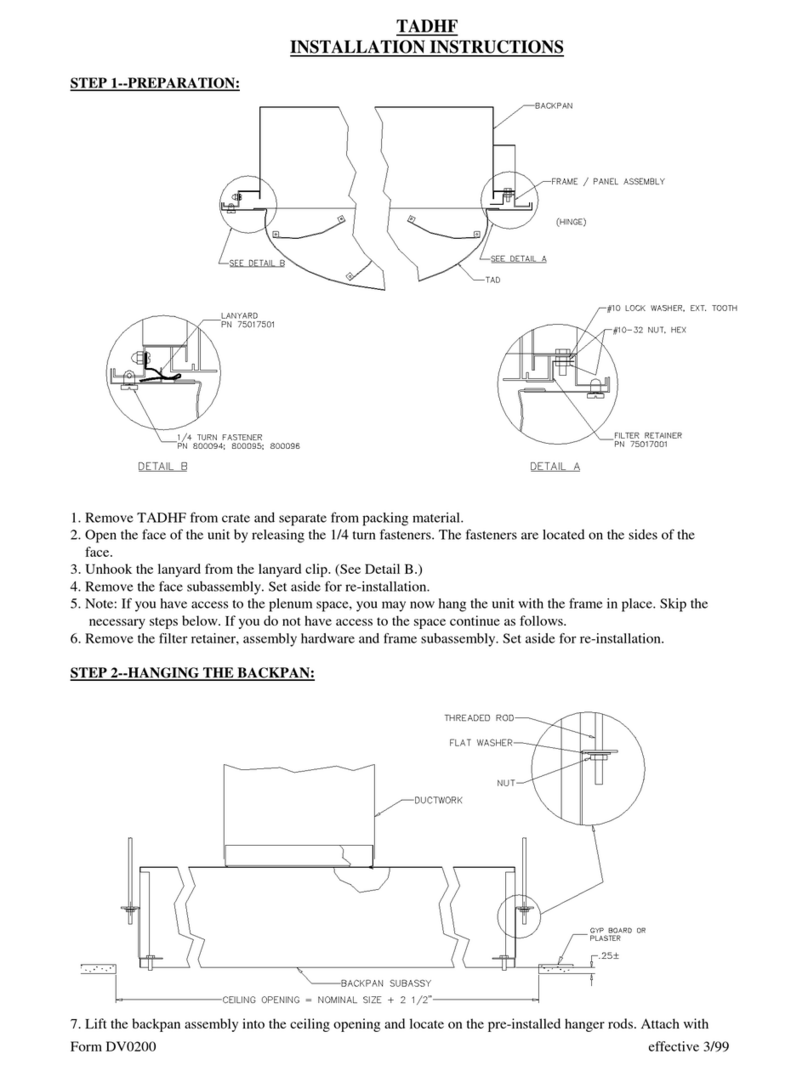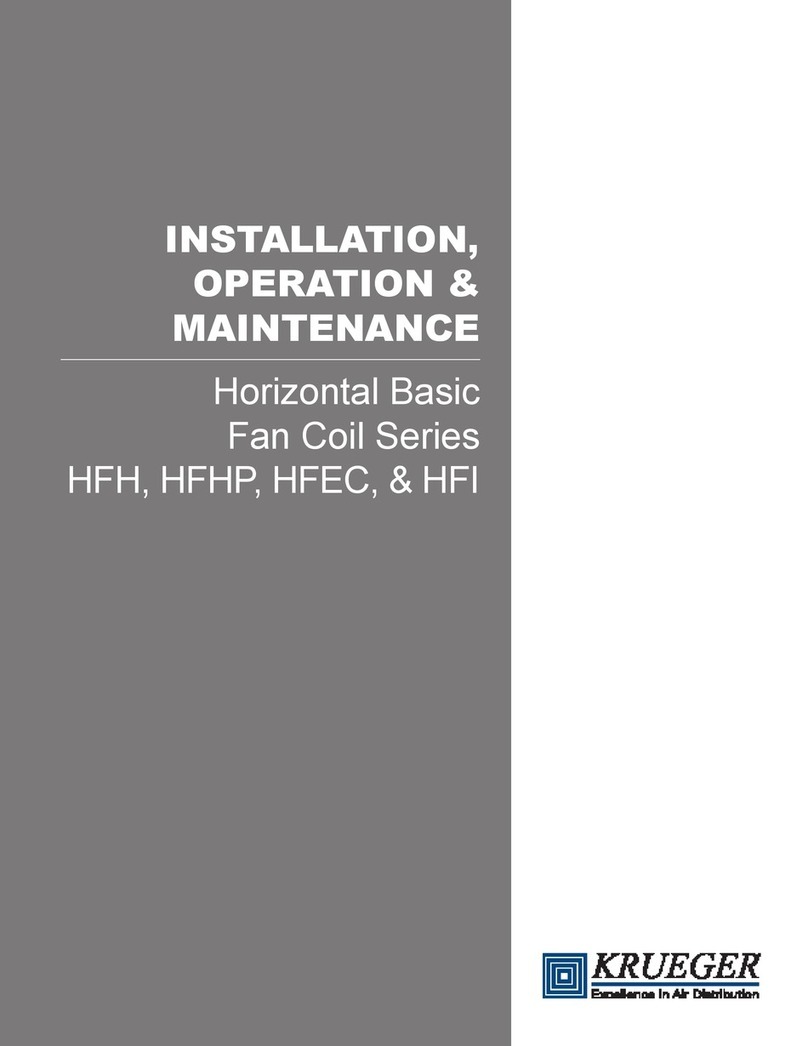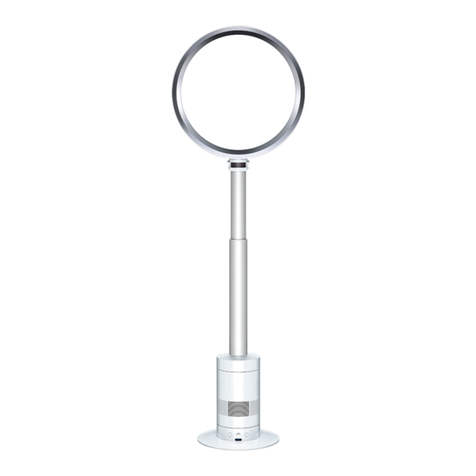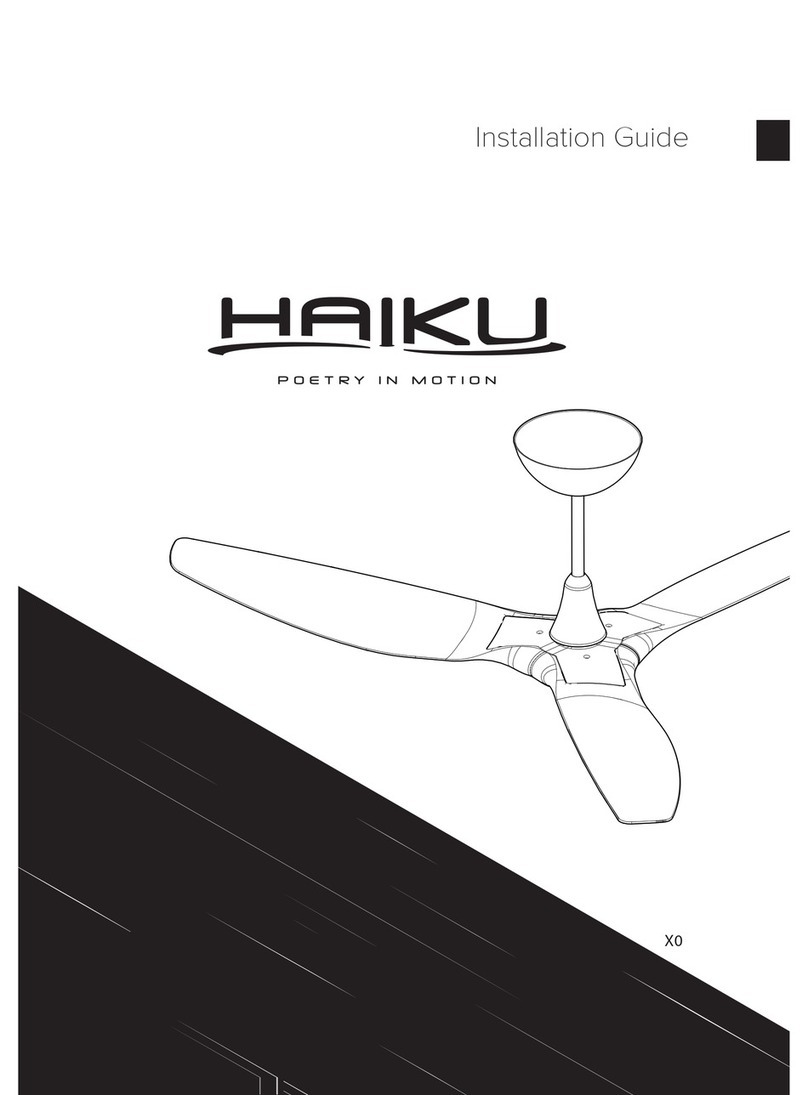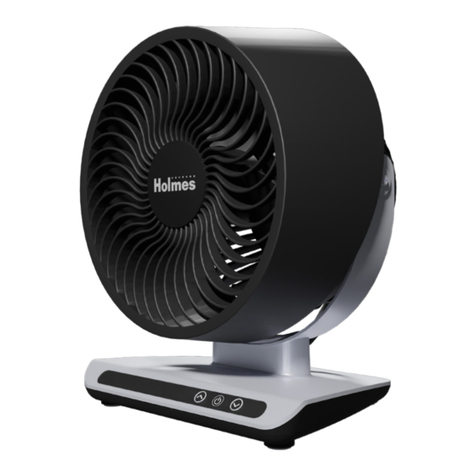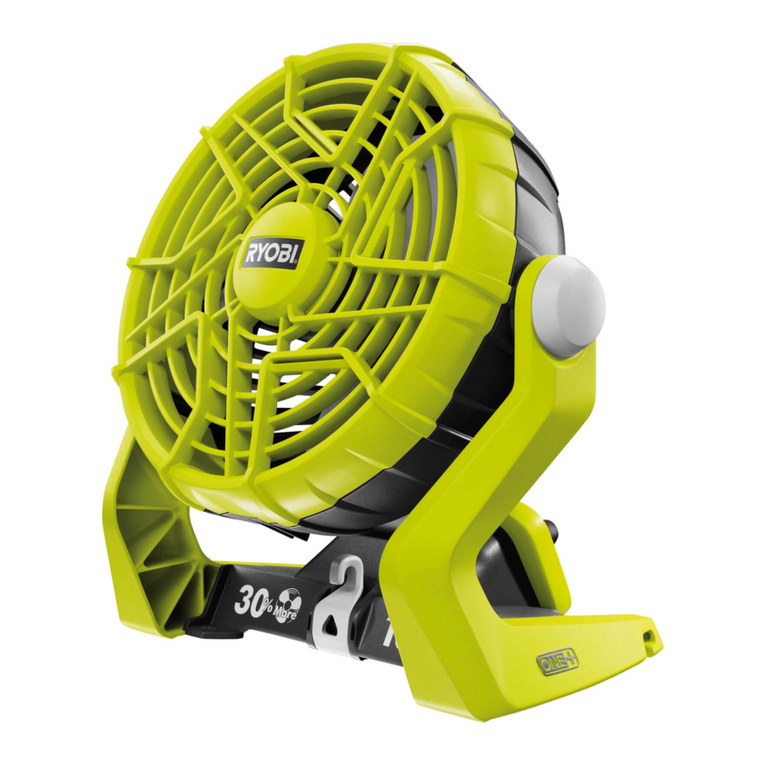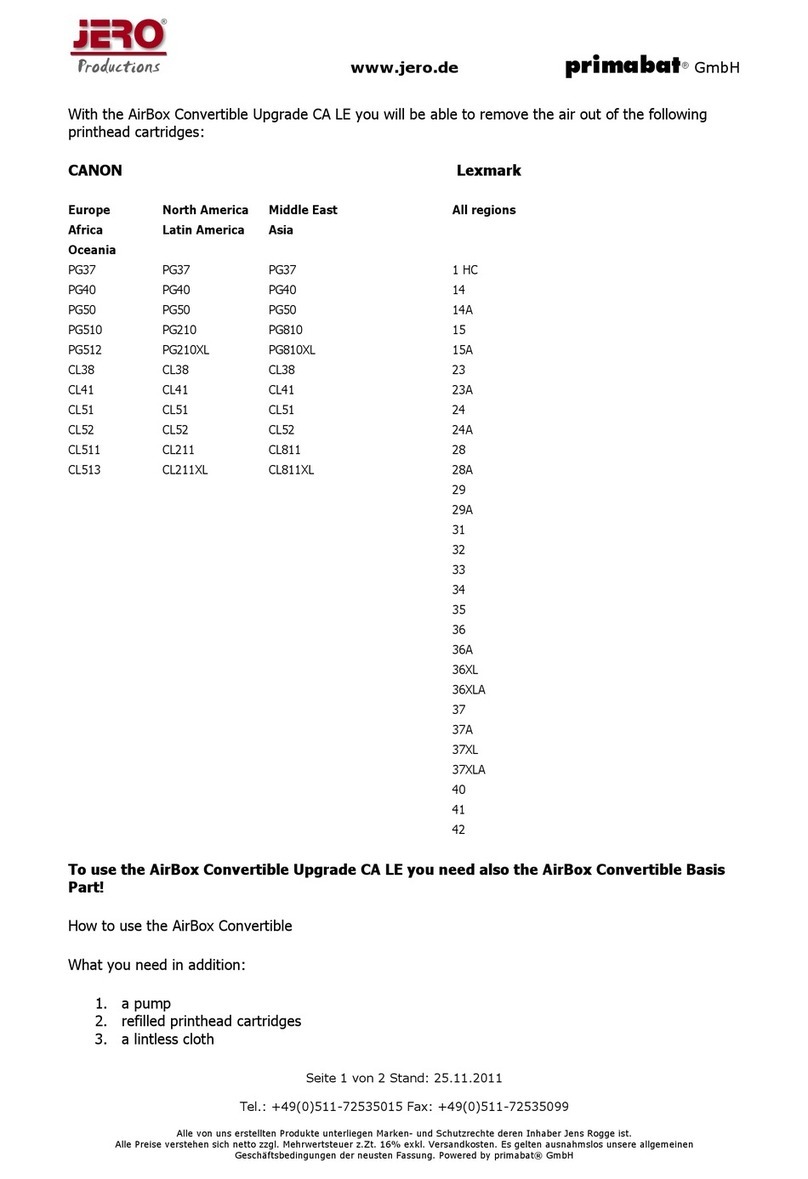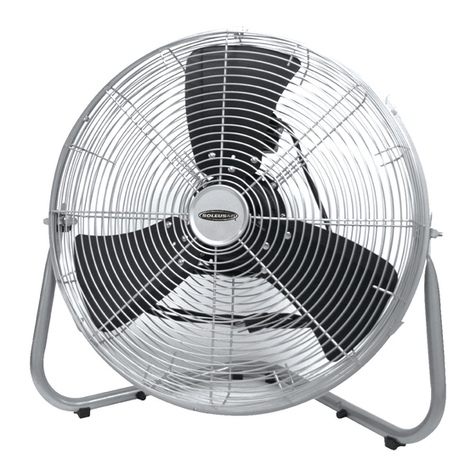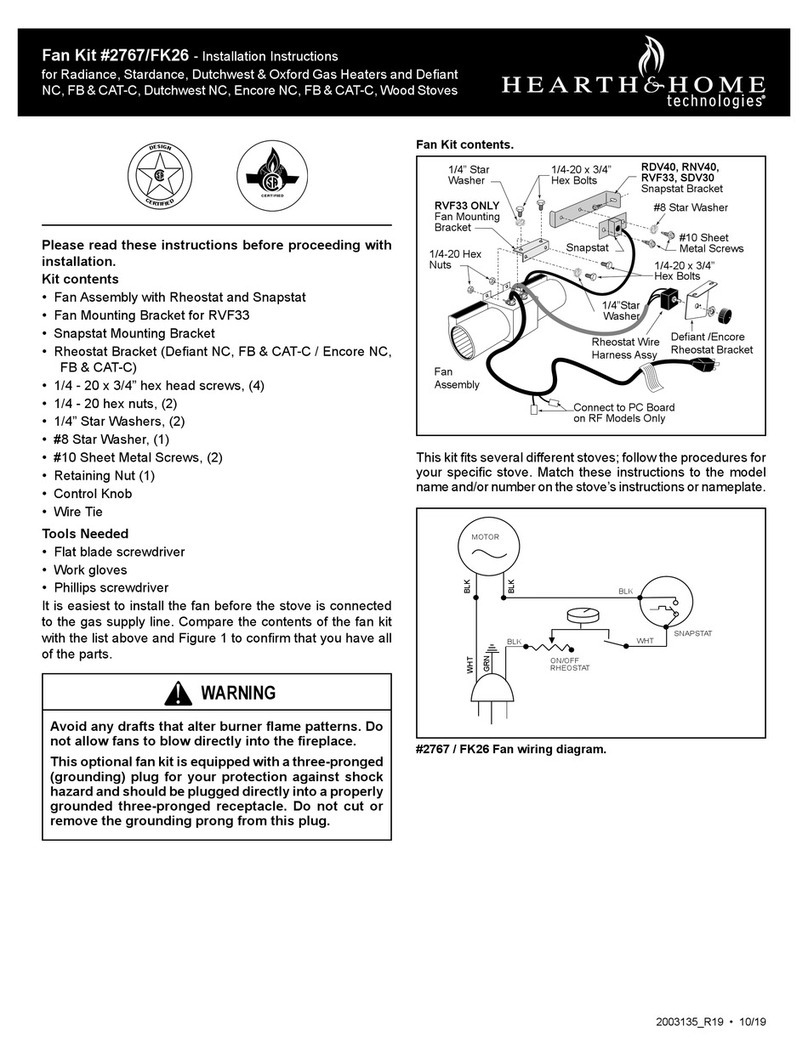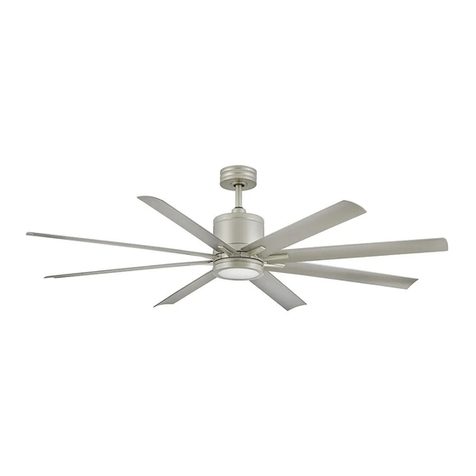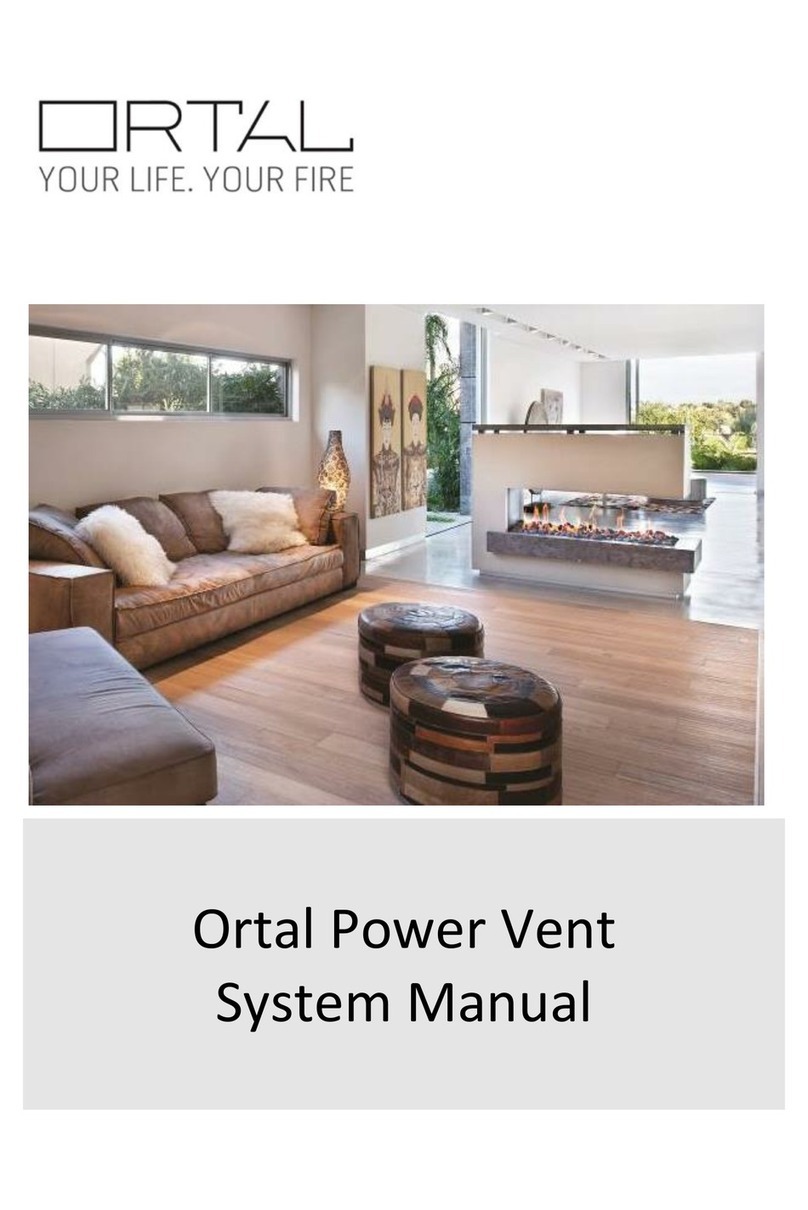KRUEGER A Series User manual

KHF - SERIES A FAN COIL UNITS
INSTALLATION, OPERATION, AND MAINTENANCE MANUAL
SAFETY SYMBOLS & CONSIDERATIONS ................ 3
SECTION ONE - RECEIPT &
INITIAL INSTALLATION ............................................. 4
KHF Series Features ................................................................................. 4
Preface ............................................................................................. 4
Unpacking & Inspection .......................................................................... 5
Handling & Installation ............................................................................ 5
Coils ............................................................................................ 6
Cooling/Heating Medium Connections ................................................ 7
Drain Pan ............................................................................................. 8
Auxiliary Drain Pans ................................................................................. 8
Ductwork Connections ............................................................................ 9
Electrical Connections ............................................................................. 9
Electrical Enclosure .................................................................................. 9
Telescoping Bottom Panel ...................................................................... 10
Model KHFP Horizontal Fan Coil Optional
Telescoping Bottom Panel Assembly,
Typical Installation Instructions ....................................................... 10
Service & Clearance Requirements ..................................................... 11
Height Restricted Application ............................................................... 12
Width Restricted Application ................................................................. 13
External Space Requirements ............................................................... 14
SECTION TWO - START-UP ....................................... 15
General ............................................................................................. 15
Cooling/Heating System .......................................................................... 15
Air System Balancing ................................................................................ 15
Motor & Fan Data ....................................................................................... 16
Water System Balancing .......................................................................... 19
Controls Operation ..................................................................................... 19
SECTION THREE - NORMAL OPERATION &
PERIODIC MAINTENANCE ........................................ 20
General, Motor/Blower Assembly, and Fan Deck ............................... 20
Coil ............................................................................................. 21
Electric Resistance Heater Assembly ................................................... 21
Electrical Wiring & Controls ................................................................... 21
Valves & Piping ........................................................................................... 21
Drain ............................................................................................ 21
Filters, Throwaway ..................................................................................... 22
Optional Item Installation ......................................................................... 23
Condensate Pump ............................................................................... 23
Current Switch Device ....................................................................... 23
Differential Air Pressure Switch ..................................................... 24
Discharge Air Sensor ......................................................................... 25
Low Temperature Cutout Control ................................................... 26
Condensate Float Switch Installation ............................................ 27
Replacement Parts .................................................................................... 27
Unit Weights ............................................................................................. 28
SECTION FOUR - INSPECTION &
START-UP CHECKLIST............................................... 29
Receiving & Inspection ............................................................................. 29
Handling & Installation ............................................................................. 29
Cooling/Heating Connections ................................................................. 29
Ductwork Connections .............................................................................. 29
Electrical Connections ............................................................................... 29
Unit Startup ............................................................................................ 29
SECTION FIVE - FAN RELAY BOARD ........................ 30
Installation, Operation and Maintenance ............................................. 30
Installation - Mounting & Wiring ............................................................ 30
FRBii Inputs and Outputs ......................................................................... 32
Jumpers and Test Points ........................................................................... 33
Screw Terminal Signals and Checking Wire Harnesses ................... 34
SECTION SIX - TROUBLESHOOTING........................ 35
TABLE OF CONTENTS

3
KHF - SERIES A FAN COIL UNITS
INSTALLATION, OPERATION, AND MAINTENANCE MANUAL
DANGER: Indicates an imminently hazardous
situation which, if not avoided, will result in death
or serious injury.
WARNING: Indicates a potentially hazardous
situation which, if not avoided, could result in death
or serious injury.
!
Danger
!
Warning
CAUTION: Identifies a hazard which could lead
to damage to the machine, damage to other
equipment and/or environmental pollution. Usually
an instruction will be given, together with a brief
explanation.
NOTE: Is used to highlight additional information
which may be helpful to you.
!
Caution
!
Note
ELECTRICAL SHOCK HAZARDS: All power must be
disconnected prior to installation and servicing this
equipment. More than one source of power may
be present. Disconnect all power sources to avoid
electrocution or shock injuries.
MOVING PARTS HAZARDS: Motor and Blower must
be disconnected prior to opening access panels.
Motors can start automatically, disconnect all
power and control circuits prior to servicing to avoid
serious crushing or dismemberment injuries.
HOT PARTS HAZARD: Electric Resistance heating
elements must be disconnected prior to servicing.
Electric Heaters may start automatically, disconnect
all power and control circuits prior to servicing to
avoid burns.
Check that the unit assembly and component
weights can be safely supported by rigging and
lifting equipment.
!
Danger
!
Danger
!
Danger
All assemblies must be adequately secured during
lifting and rigging by temporary supports and
restraints until equipment is permanently fastened
and set in its final location.
All unit temporary and permanent supports must
be capable of safely supporting the equipment’s
weight and any additional live or dead loads that
may be encountered. All supports must be designed
to meet applicable local codes and ordinances.
All fastening devices must be designed to
mechanically lock the assembly in place without
the capability of loosening or breaking away due to
system operation and vibration.
Protect adjacent flammable materials when brazing,
Use flame and heat protection barriers where
needed. Have fire extinguisher available and ready
for immediate use.
!
Warning
!
Warning
!
Warning
!
Warning
!
Caution
SAFETY CONSIDERATIONS
The equipment covered by this manual is designed for safe and reliable operation when installed and operated within its
design specification limits. To avoid personal injury or damage to equipment or property while installing or operating this
equipment, it is essential that qualified, experienced personnel perform these functions using good judgment and safe
practices. See the following cautionary statements.
SAFETY SYMBOLS
The following symbols are used in this document to alert the reader to areas of potential hazard:

4
KHF - SERIES A FAN COIL UNITS
INSTALLATION, OPERATION, AND MAINTENANCE MANUAL
SECTION 1 - RECEIPT & INITIAL INSTALLATION
KHF - SERIES A FEATURES
PREFACE
Krueger fan coils represent a prudent investment which can,
with proper installation, operation, and regular maintenance,
give trouble-free operation and long service.
Your equipment is initially protected under the
manufacturer’s standard warranty; however, this warranty
is provided under the condition that the steps outlined
in this manual for initial inspection, proper installation,
regular periodic maintenance, and everyday operation of
the equipment be followed in detail. This manual should be
fully reviewed in advance of any actual work being done on
the equipment. Should any questions arise, please contact
your local Sales Representative or the factory BEFORE
proceeding.
The equipment covered by this manual is available with a
vast variety of options and accessories. Consult the approved
unit submittal, order acknowledgement, and other manuals
for details on the options and accessories provided with the
equipment on each project.
The manufacturer assumes no responsibility for personal
injury or property damage resulting from improper or
unsafe practices during the handling, installation, service, or
operation of any equipment.
!
Caution
No attempt should be made to handle, install, or
service any unit without following safe practices
regarding mechanical equipment.
All power must be disconnected before any
installation or service should be attempted. More
than one power source may be supplied to a unit.
Power to remote mounted control devices may not
be supplied through the unit. Never wear bulky
or loose fitting clothing when working on any
mechanical equipment. Gloves should only be worn
when required for proper protection from heat
or other possible injury. Safety glasses or goggles
should always be worn when drilling, cutting, or
working with chemicals such as refrigerants or
lubricants.
Never pressurize any equipment beyond specified
operating pressures. Always pressure test with
some inert fluid or gas such as clear water or dry
nitrogen to avoid possible damage or injury in the
event of a leak or component failure during testing.
Always protect adjacent flammable material when
welding, brazing or soldering. Use suitable heat
shield material to contain sparks or drops of solder.
Have fire extinguisher available for use when
welding or brazing.
!
Caution
!
Caution
!
Caution
Electric heat
Controls
Blower
Outside air duct
collar
Filter access
(not shown)
Valve package
(factory mounted
or shipped loose)
Coils
Supply air
Right or left hand coil
and drain connections,
same or opposite end
Removable
drain pan
Condensate
pump
Auxiliary
drain pan
Return air
Motor

5
KHF - SERIES A FAN COIL UNITS
INSTALLATION, OPERATION, AND MAINTENANCE MANUAL
UNPACKING & INSPECTION
All units are carefully inspected at the factory throughout
the manufacturing process under a strict detailed quality
assurance program, and where possible, all major
components and subassemblies are carefully tested for
proper operation and verified to be in full compliance with
the factory manufacturing documents. Customer furnished
components such as control valves, switches and DDC
controls are not factory tested.
Each unit is carefully packaged for shipment to avoid damage
during normal transport and handling. The equipment should
always be stored in a dry place in the proper orientation as
marked on the carton.
All shipments are made F.O.B. factory and it is the
responsibility of the receiving party to inspect the equipment
upon arrival. Any obvious damage to the carton and/or its
contents should be recorded on the bill of lading and a claim
should be filed with the freight carrier.
After determining the condition of the carton exterior,
carefully remove each unit from the carton and inspect
for hidden damage. At this time check to make sure that
“furnished only” items such as switches, thermostats, etc.,
are accounted for. Any hidden damage should be recorded
and immediately reported to the carrier and a claim must
be filed. In the event a claim for shipping damage is filed,
the unit, shipping carton, and all packing must be retained
for physical inspection by the freight carrier. All equipment
should be stored in the factory shipping carton with internal
packing in place until installation.
At the time of receipt, the equipment type and arrangement
should be verified against the order documents. Should
any discrepancy be found, the local Sales Representative
should be notified immediately so that the proper action
may be instituted. Should any question arise concerning
warranty repairs, the factory must be notified BEFORE any
corrective action is taken. Where local repairs or alterations
can be accomplished, the factory must be fully informed
as to the extent and expected cost of those repairs before
work is begun. Where factory operations are required,
the factory must be contacted for authorization to return
equipment and a Return Authorization Number will be
issued. Unauthorized return shipments of equipment and
shipments not marked with an authorization number will be
refused. In addition, the manufacturer will not accept any
claims for unauthorized expenses.
CODE COMPLIANCE
This equipment has been manufactured and certified in
accordance with UL 1995-Standard for Safety, Heating and
Cooling Equipment (CAN/CSA C22.2 NO 236- M90) and bears
the Electrical Testing Laboratories (ETL) Mark under ETL File
No.: 3036742-002.
HANDLING & INSTALLATION
While all equipment is designed for durability and fabricated
for sturdy construction and may present a rugged
appearance, great care must be taken to assure that no
force or pressure be applied to the coil, piping or drain stub-
outs during handling. Also, depending on the options and
accessories, some units could contain delicate components
that may be damaged by improper handling. Wherever
possible, all units should be maintained in an upright
position and handled by the chassis as close as possible to
the mounting point locations.
In the case of a full cabinet unit, the unit must obviously be
handled by the exterior casing. This is acceptable providing
the unit is again maintained in an upright position and
no impact forces are applied that may damage internal
components, access panels, or painted surfaces. The
equipment covered in this manual IS NOT suitable for
outdoor installations. The equipment should never be
stored or installed where it may be subjected to a hostile
environment such as rain, snow, or extreme temperatures.
During and after installation, special care must be taken to
prevent foreign material such as paint, plaster, and drywall
dust from being deposited in the drain pan or on the motor
or blower wheels. Failure to do so may have serious adverse
effects on unit operation and in the case of the motor and
blower assembly, may result in immediate or premature
failure. All manufacturers’ warranties are void if foreign
material is allowed to be deposited on the motor or blower
wheels of any unit. Some units and/or job conditions
may require some form of temporary covering during
construction.
While the manufacturer does not become involved in the
design and selection of support methods and components,
it should be noted that unacceptable system operating
characteristics and/or performance may result from
improper or inadequate unit structural support. In addition,
adequate clearance must be provided for service and
removal of the equipment and its accessory components.
Anchoring the equipment in place is accomplished by using
the mounting points provided and positioning the unit
to maintain the unit on a LEVEL plane. The drain pan is
internally sloped toward the outlet connection. Care must
be taken to insure that the unit drain pan does not slope
away from the outlet connection. All units are supplied with
integrated hanger brackets with optional grommet isolators
and brass inserts for use with 3/8” all thread hanger rod.
The unit’s drain pan is factory sloped toward the
unit’s drain pan drain connection when the unit is
installed level and plumb.
!
Note

6
KHF - SERIES A FAN COIL UNITS
INSTALLATION, OPERATION, AND MAINTENANCE MANUAL
COILS
All fan coils are available in 2 or 4 pipe configurations.
Heating coils are available in reheat or preheat position.
Heating and cooling coils are available with right, left or
opposite side connections.
Verify that the proper types of service are actually provided
to the unit. On units with steam heating coils, the maximum
steam pressure applied to the unit should never exceed
15 PSIG. The drain piping and steam trap should be sized
and routed to allow for proper condensate flow. The
electrical service to the unit should be compared to the
unit nameplate to verify compatibility. The routing and
sizing of all piping, and the type and sizing of all wiring
and other electrical components such as circuit breakers,
disconnect switches, etc., should be determined by the
individual job requirements and should not be based on the
size and/or type of connection provided on the equipment.
All installations should be made in compliance with all
governing codes and ordinances. Compliance with all codes
is the responsibility of the installing contractor.
Figure 1: Typical ceiling installation
TYPICAL CEILING INSTALLATION
THREADED ROD
SIDE VIEW
DETAIL A
NUT
OPTICAL VIBRATION
ISOLATOR
NUT
WASHER
WASHER
FAN COIL UNIT
KHFE
KHFH
KHFP

7
KHF - SERIES A FAN COIL UNITS
INSTALLATION, OPERATION, AND MAINTENANCE MANUAL
If the valve package connection at the coil is made with a
union, the coil side of the union must be prevented from
twisting (“backed up”) during tightening to prevent damage
to the coil tubing. Over-tightening must be avoided to prevent
distorting the union seal surface and destroying the union.
Due to the diversity of valve packages for this product, install
the valve packages with no leaks or interference between
components during operation and maintenance. In the case
of field installed valves and piping, the chilled water valve
cluster (or metering device on DX units) should be installed in
such a way that any dripping or sweating is contained in the
auxiliary drain pan or other device. Valves and TXV’s should
be secured or supported to avoid damage to coil headers or
distributor tubes. All valves, pipes, and components must
be sufficiently supported to ensure structural integrity and
proper operation of the unit.
After the connections are completed, the system should
then be tested for leaks. Since some components are not
designed to hold pressure with a gas, hydronic systems
should be tested with water.
All water coils must be protected from freezing
after initial filling with water. Even if the system is
drained, unit coils may still hold enough water to
cause damage when exposed to temperatures
below freezing.
Refrigerant systems should be tested with dry nitrogen
rather than air to prevent the introduction of moisture
into the system. In the event that leaking or defective
components are discovered, the Sales Representative must
be notified BEFORE any repairs are attempted. All leaks
should be repaired before proceeding with the installation.
!
Caution
COOLING/HEATING MEDIUM CONNECTIONS
Toxic residues and loose particles resulting from
manufacturing and field piping techniques such
as joint compounds, soldering flux, and metal
shavings may be present in the unit and the piping
system. Not for use with domestic or potable water
systems.
Submittals and Product Catalogs detailing unit operation,
controls, and connections should be thoroughly reviewed
BEFORE beginning the connection of the various cooling
and/or heating mediums to the unit.
All accessory valve packages should be installed as required,
and all service valves should be checked for proper
operation. To prevent condensation accumulation and
runoff, chilled water valve packages must be insulated, or
preferably, utilize a factory-provided auxiliary drip tray.
Before brazing or sweating valve packages and their
components into place, it is critical to pre-check all
valve package clearances in relation to the auxiliary
drain pan. If the auxiliary drain pan cannot be
properly affixed to the auxiliary drain pan support
bracket, adjust valve package component angles
until proper clearance is achieved.
!
Caution
!
Note
If coil and valve package connections are to be made with
“sweat” or solder joint, care should be taken to assure that
no components in the valve package are subjected to a high
temperature which may damage seals or other materials.
Many two-position electric control valves, depending on
valve operation, are provided with a manual-opening lever.
This lever should be placed in the “open” position during
all soldering or brazing operations. Valve bodies should be
wrapped with a wet rag to help dissipate heat encountered
during brazing.

8
KHF - SERIES A FAN COIL UNITS
INSTALLATION, OPERATION, AND MAINTENANCE MANUAL
Figure 2a
Figure 2d | Figures 2a-2d: Typical drain pan removal
Figure 2b Figure 2c
DRAIN PAN
Standard drain pans are externally insulated, single wall
galvanized steel and can be equipped with a secondary
drain connection. The KHF drain pan is easily removable for
cleaning. See illustration below. Auxiliary drip pan to catch
condensed moisture from valves and piping must be sloped
toward the drain pan.
The condensate drain pan can be removed without requiring
common hand tools. The drain pan is secured to the unit by
four sheet metal tabs that slide into four respective slots on
the drain pan.
Prior to removing the drain pan, make sure all accessories
and field connections have been appropriately disconnected
from the drain pan. The drain pan can be removed in three
steps. First, push the drain pan engagement lever to unlock
the drain pan from the coil. Next, while continuing to push
the lever, support the weight of the drain pan and slide the
drain pan towards the drain connection. After the drain
pan slides approximately 1.5 inches, it will be completely
disengaged from the coil. Lastly, support the weight of
the drain pan and safely lower the drain pan for servicing.
Reinstall prior to unit startup.
Figure 3a
Figure 3b
Figure 3a-3b: Typical auxiliary drain pan removal
AUXILIARY DRAIN PANS
Mounted directly to the unit drain pan, AUXILIARY DRAIN
PANS may also be secured by the mounting holes to field
supports or to the unit coil utilizing pipe hanger wire, plastic
ties, or metal strapping.
Prior to removing the auxiliary drain pan, make sure all
accessories have been appropriately disconnected from the
auxiliary drain pan. The auxiliary drain pan can be removed
in three steps. First, remove the two screws that attached
the auxiliary drain pan to the support bracket near the inlet
of the unit. Next, support the weight of the auxiliary drain
pan and slide the auxiliary drain pan towards the discharge
of the unit so the auxiliary drain pan lip will clear the drain
pan lip. After the auxiliary drain pan slides approximately
0.75 inches, the auxiliary drain pan will be free from the
drain pan. Lastly, support the weight of the auxiliary drain
pan and safely lower for servicing. Reinstall prior to unit
startup.

9
KHF - SERIES A FAN COIL UNITS
INSTALLATION, OPERATION, AND MAINTENANCE MANUAL
DUCTWORK CONNECTIONS
All ductwork and/or supply and return grilles should
be installed in accordance with the project plans and
specifications. If not included on the unit or furnished from
the factory, Krueger supply and return grilles are available in
a variety of types.
Units can be configured from the factory with duct collars for
attaching ductwork. The factory suggests using galvanized
sheet metal ductwork or a flexible canvas attached to the
duct collars using sheet metal screws. Duct connections
should follow SMACNA standards and national and local
codes.
All units must be installed in non-combustible areas. Some
models are designed to be connected to ductwork with
a MINIMUM amount of external static pressure. Consult
the approved submittals and the product catalog for unit
external static pressure limitations.
Units provided with outside air for ventilation should have
some form of low temperature protection to prevent coil
freeze-up.
It should be noted that none of these methods would
adequately protect a coil in the event of power failure.
The safest method of freeze protection is to use glycol in
the proper percent solution for the coldest expected air
temperature.
The manufacturer assumes no responsibility for undesirable
system operation due to improper design, equipment or
component selection, and/or installation of ductwork,
grilles, and other field supplied components.
ELECTRICAL CONNECTIONS
The unit nameplate lists the unit electrical characteristics
such as the required supply voltage, fan and heater
amperage and required circuit ampacities. The unit wiring
diagram shows all unit and field wiring. Since each project
is different and each unit on a project may be different,
the installer must be familiar with the wiring diagram and
nameplate on the unit BEFORE beginning any wiring. This
unit is not acceptable for installation in hazardous/explosive
areas.
Figure 4: Electrical enclosure
ELECTRICAL ENCLOSURE
The electrical control enclosure provides access to the
electrical compartment. This compartment houses all
electric heat and control components. Terminal strips are
furnished for simple power and control wiring connections.
Multiple knockouts allow wiring entries from either side of
the compartment.
All components furnished for field installation, by either the
factory or the controls contractor should be located and
checked for proper function and compatibility. All internal
components should be checked for shipping damage. After
installation and before energizing the unit, verify voltage
and check that all electrical connections are tight. Electrical
connections should be periodically checked for tightness.
Any devices such as fan switches or thermostats that have
been furnished from the factory for field installation must
be wired in strict accordance with the applicable wiring
diagrams. Failure to do so could result in personal injury
or damage to components and will void all manufacturers’
warranties.
All field wiring should be done in accordance with governing
codes and ordinances. Any modification of the unit wiring
without factory authorization will result in voiding of all
factory warranties and will nullify any agency listings.
The manufacturer assumes no responsibility for any
damages and/or injuries resulting from improperly field
installed or wired components.
This unit is listed to UL/CSAS standards. All modifications to
line voltage wiring must be performed in accordance with
the NEC and inspected by ETL to maintain product listing.
Unauthorized modification to any wiring may impact unit
performance and void ETL listing and/or product warranty.

10
KHF - SERIES A FAN COIL UNITS
INSTALLATION, OPERATION, AND MAINTENANCE MANUAL
TABLE 1: TELESCOPING BOTTOM PANEL WEIGHTS (LBS./KG)
DESCRIPTION
UNIT SIZE
02 03 04 06 08 09 10 12
Telescoping bottom panel 10 (5) 11 (5) 12 (5) 14 (6) 16 (7) 17 (8) 20 (9) 21 (10)
OPTIONAL TELESCOPING BOTTOM PANEL ASSEMBLY, TYPICAL INSTALLATION INSTRUCTIONS
TELESCOPING BOTTOM PANEL
The telescoping bottom panel allows for fully recessing the unit while permitting service access into the ceiling plenum. The
architectural ceiling panel is finished with a durable powder coat paint.
Portions of the inlet louver not directly below unit inlet may require covering in the field on applications where
infiltration of ceiling plenum air into space is undesired. Telescoping skirt and collar assembly must be field adjusted
to assure a proper fit between filter frame and louvered inlet panel assembly. Refer to assembly submittal drawings
for specific dimensions.
Drawings are subject to change without notice. Refer to www.krueger-hvac.com for current submittal drawings.
!
Note
SIDE VIEW
INLET COLLAR INSTALLATION
KHFP UNIT CHASSIS
SCREW THE TELESCOPING PANEL TO THE CHASSIS
(2 SCREWS BOTH SIDES)
SUSPENDED GRID/TILE CEILING SYSTEM
CEILING GRID
TEE-BAR TELESCOPING BOTTOM
PANEL FRAME EXTRUSION
ACOUSTIC FIBRE
CEILING TILE
SOLID OR LOUVERED
BOTTOM PANEL
STUD/DRYWALL CEILING SYSTEM
METAL OR WOOD
CEILING STUD
SHIM AS REQUIRED
TELESCOPING BOTTOM
PANEL FRAME EXTRUSION
SOLID OR LOUVERED
BOTTOM PANEL
SHEET METAL OR WOOD
SCREW AS REQUIRED
SEE NOTES 4 & 6
SHEET METAL OR WOOD
SCREW AS REQUIRED
SEE NOTES 4 & 6
SHIM AS REQUIRED
DRYWALL CEILING
SIDE VIEW
TYPICAL INSTALLATION METHODS
10 1/2"
(264)
7” (178)
10 1/2” (267)
AIR
OPEN THIS PANEL FIRST
FINISHED
CEILING LINE
NOTE: Ceiling tee bar grid may not support telescoping bottom panel assembly. Bottom panel assembly may require independent support.
KHF HORIZONTAL FAN COIL

11
KHF - SERIES A FAN COIL UNITS
INSTALLATION, OPERATION, AND MAINTENANCE MANUAL
SERVICE AND CLEARANCE REQUIREMENTS
FRONT PANEL (STRUCTURAL)
CORNER PANEL
(REMOVABLE)
BOTTOM PANEL “TRAP DOOR” (REMOVABLE)
RIGHT VIEW
TRAP DOOR FULLY OPENED
FRONT VIEW
TRAP DOOR FULLY OPENED
BOTTOM VIEW
TRAP DOOR FULLY CLOSED
10.5” (267)
REAR RETURN
FILTER CLEARANCE
TRAP DOOR RETAINED BY 1/4 TURN HARDWARE
REMOVE TRAP DOOR TO ACCESS
- AIR FILTER
- BLOWER ACCESS PANEL
- ELECTRIC HEAT ACCESS PANEL
- CORNER PANEL MOUNTING HARDWARE
9.5” (241)
BOTTOM RETURN
FILTER CLEARANCE
BACK PANE
(STRUCTURAL)
HORIZONTAL, LOW PROFILE EXPOSED UNITS

12
KHF - SERIES A FAN COIL UNITS
INSTALLATION, OPERATION, AND MAINTENANCE MANUAL
SERVICE AND CLEARANCE REQUIREMENTS: HEIGHT RESTRICTED APPLICATION
CORNER PANELS
SHOWN ROTATED 90°
UNIT
INSTALLED
0" CLEARANCE BETWEEN UNIT AND STRUCTURE
FULLY
OPENED
CORNER PANELS ROTATED 90°
CAN BE LIFTED AND REMOVED
11" (279) MINIMUM REQUIRED
CLEARANCE BESIDE UNIT
HALF
OPENED
CORNER PANELS ROTATE
ABOUT PIVOT POINT
4" (102) MINIMUM REQUIRED
CLEARANCE BELOW UNIT
0" REQUIRED CLEARANCE
ABOVE UNIT
HORIZONTAL, LOW PROFILE EXPOSED UNITS

13
KHF - SERIES A FAN COIL UNITS
INSTALLATION, OPERATION, AND MAINTENANCE MANUAL
SERVICE AND CLEARANCE REQUIREMENTS: WIDTH RESTRICTED APPLICATION
CORNER PANELS SHOWN
LIFTED AND ROTATED 5°
DROP CORNER PANELS
STRAIGHT DOWN
UNIT
INSTALLED
HALF
OPENED
FULLY
OPENED
3" (76) MINIMUM REQUIRED
CLEARANCE BESIDE UNIT
(PANEL REMOVAL REQUIRED
FOR ELECTRICAL ACCESS)
1" (25) MINIMUM REQUIRED
CLEARANCE ABOVE UNIT
LIFT AND ROTATE CORNER PANEL
OFF OF PIVOT POINT
ABIDE BY APPLICABLE
CODES AND STANDARDS
REGUARDING ACCESS
FOR ELECTRICAL OR
PLUMBING COMPONENTS
3" (76) CLEARANCE BETWEEN
STRUCTURE AND UNIT
3" (76) CLEARANCE BETWEEN
STRUCTURE AND UNIT
HORIZONTAL, LOW PROFILE EXPOSED UNITS

14
KHF - SERIES A FAN COIL UNITS
INSTALLATION, OPERATION, AND MAINTENANCE MANUAL
SERVICE AND CLEARANCE REQUIREMENTS: EXTERNAL SPACE REQUIREMENTS
NOTES:
1. All chilled water piping that projects beyond the condensate pan or the optional auxiliary drip pan must be field insulated by others.
2. Auxiliary drip pan shown above is optional, and is mounted on the outlet side of the drain pan.
3. Drain pan is installed with the outlet tube(s) on cooling coil connection end of coil on 4-pipe units with optional opposite end connection.
4. Dimensions shown on this drawing apply to standard CW and HW valve packages. Refer to the Piping Package Catalog for valve package code details.
Contact factory for details on valve packages using non-standard or customer furnished components.
5. Provide sufficient clearance to access electrical components and comply with all applicable codes and ordinances.
8 1/2" (216)
OPTIONAL AUXILIARY
DRIP PAN
SUPPLY AIR OPENING WIDTH
10 1/2" (267)
AIR FILTER CLEARANCE
FRONT VIEW
8" (204)
1" (25)
CONTROL
ENCLOSURE
SEE NOTE 5
OPTIONAL
SIDE ACCESS
22" (559)
TOP VIEW
HORIZONTAL, LOW PROFILE PLENUM AND FREE RETURN

15
KHF - SERIES A FAN COIL UNITS
INSTALLATION, OPERATION, AND MAINTENANCE MANUAL
GENERAL
Before beginning any start-up operation, the startup
personnel should familiarize themselves with the unit,
options and accessories, and control sequence to
understand the proper system operation. All personnel
should have a good working knowledge of general start-up
procedures and have the appropriate start-up and balancing
guides available for consultation.
The initial step in any startup operation should be a final
visual inspection. All equipment, plenums, ductwork, and
piping should be inspected to verify that all systems are
complete and properly installed and mounted, and that no
debris or foreign articles such as paper or drink cans are
left in the units or other areas. Each unit should be checked
for loose wires, free blower wheel operation, and loose or
missing access panels or doors. Except as required during
start-up and balancing operations, no fan coil units should
be operated without all the proper ductwork attached,
supply and return grilles in place, and all access doors and
panels in place and secure. A clean filter of the proper size
and type must also be installed. Failure to do so could result
in damage to the equipment or building and furnishings,
and/or void all manufacturers’ warranties.
Fan coils are not intended for temporary heat/cool or
ventilation. Units are not designed or equipped to operate
in dusty construction environments. Operation of the units
in conditions outlined above could result in damage to
the equipment or building and furnishings and/or void all
manufacturer’s warranties.
COOLING/HEATING SYSTEM
Prior to the water system start-up and balancing, the chilled/
hot water systems should be flushed to clean out dirt and
debris, which may have collected in the piping during
construction. During this procedure, all unit service valves
must be in the closed position. This prevents foreign matter
from entering the unit and clogging the valves and metering
devices. Strainers should be installed in the piping mains to
prevent this material from entering the units during normal
operation.
During systemfilling,airventing from theunitisaccomplished
by the use of the standard manual, or optional automatic,
air vent fitting installed on the coil. In the case of the manual
air vent fitting, the screw should be turned counterclockwise
no more than 1-½ turns to operate the air vent. Automatic
air vents may be unscrewed one turn counterclockwise to
speed initial venting but should be screwed in for automatic
venting after start-up operations. Check to ensure that no
leaks are prevalent at the coils, coil connections, piping
packages, etc.
The air vent provided on the unit is not intended
to replace the main system air vents and may not
release air trapped in other parts of the system.
Inspect the entire system for potential air traps
and vent those areas as required, independently.
In addition, some systems may require repeated
venting over a period of time to properly eliminate
air from the system.
!
Caution
AIR SYSTEM BALANCING
All ductwork must be complete and connected, and all grilles, filters, access doors and panels must be properly installed to
establish actual system operating conditions BEFORE beginning air balancing operations.
Each individual unit and attached ductwork is a unique system with its own operating characteristics. For this reason, air
balancing is normally done by balance specialists who are familiar with all procedures required to properly establish air
distribution and fan system operating conditions. These procedures should not be attempted by unqualified personnel.
Some selections may require air balancing in the field.
After the proper system operation is established, the actual unit air delivery and the actual fan motor amperage draw for
each unit should be recorded in a convenient place for future reference such as the inspection, installation, & start-up check
sheet, a copy of which is provided on the back of this manual. Contact the Sales Representative or the factory for additional
copies of this sheet.
SECTION TWO - START-UP

16
KHF - SERIES A FAN COIL UNITS
INSTALLATION, OPERATION, AND MAINTENANCE MANUAL
MOTOR AND FAN DATA
TABLE 2A: PSC MOTORS - KHFP, KHFE
UNIT SIZE PSC MOTOR HP
(QTY) # OF FANS FAN SPEED WATTS2
115 VOLTS 208/230 VOLTS 277 VOLTS
AMPS1AMPS1AMPS1
02 (1) 1/3031
High 55
0.5 N/A N/AMedium 40
Low 36
03 (1) 1/3031
High 61
0.5 N/A N/AMedium 45
Low 40
04 (1) 1/20 2
High 75
0.8 0.4 0.5Medium 65
Low 58
06 (1) 1/20 2
High 80
0.8 0.4 0.5Medium 68
Low 56
08 (1) 1/10 2
High 122
1.1 0.6 0.5Medium 83
Low 66
09 (1) 1/10 2
High 127
1.1 0.6 0.5Medium 86
Low 66
10 (2) 1/20 4
High 148
1.6 0.8 1Medium 128
Low 110
12 (2) 1/20 4
High 160
1.6 0.8 1Medium 139
Low 115
NOTES:
1. Motor electrical data is nameplate data.
2. Watts are based on an KHFP with PSC motor, 3 row coil, 12FPI, 1” throwaway filter, 0.05” ESP at 115V.
3. PSC motors are not available in 208-277V on SZ02 and SZ03.
4. Motor data is subject to change and should not be used for submittal purposes.

17
KHF - SERIES A FAN COIL UNITS
INSTALLATION, OPERATION, AND MAINTENANCE MANUAL
MOTOR AND FAN DATA
TABLE 2B: PSC MOTORS, MODEL KHFH
UNIT SIZE PSC MOTOR HP
(QTY) # OF FANS FAN SPEED WATTS2
115 VOLTS 208/230 VOLTS 277 VOLTS
AMPS1AMPS1AMPS1
02 (1) 1/3031
High 55
0.5 N/A N/AMedium 40
Low 36
03 (1) 1/3031
High 61
0.5 N/A N/AMedium 45
Low 40
04 (1) 1/20 2
High 75
0.8 0.4 0.5Medium 65
Low 58
06 (1) 1/10 2
High 121
1.1 0.6 0.5Medium 84
Low 66
08 (1) 1/6 2
High 224
2.1 1.1 0.9Medium 140
Low 66
09 (1) 1/6 2
High 230
2.1 1.1 0.9Medium 139
Low 67
10 (2) 1/10 4
High 226
2.2 1.2 1Medium 154
Low 128
12 (2) 1/10 4
High 248
2.2 1.2 1Medium 171
Low 133
NOTES:
1. Motor electrical data is nameplate data.
2. Watts are based on an KHFH with PSC motor, 3 row coil, 12FPI, 1” throwaway filter, 0.05” ESP at 115V.
3. PSC motors are not available in 208-277V on SZ02 and SZ03.
4. Motor data is subject to change and should not be used for submittal purposes.

18
KHF - SERIES A FAN COIL UNITS
INSTALLATION, OPERATION, AND MAINTENANCE MANUAL
TABLE 3: EC MOTORS
UNIT SIZE FAN SPEED EC MOTOR HP
(QTY) # OF FANS WATTS2
(STD/HS)
AMPS1,3
115 VOLTS 208/230 VOLTS 277 VOLTS
3-SPEED
(STD/HS) 2-10VDC 3-SPEED
(STD/HS) 2-10VDC 3-SPEED
(STD/HS) 2-10VDC
02
High
(1) 1/4 1
32 / 45
0.7 / 1.0 0.9 0.5 / 0.6 0.5 0.4 / 0.5 0.5Medium 21 / 36
Low 14 / 26
03
High
(1) 1/4 1
35 / 59
1.0 / 1.5 1.1 0.6 / 0.9 0.7 0.5 / 0.8 0.6Medium 23 / 43
Low 16 / 33
04
High
(1) 1/4 2
50 / 75
1.5 / 1.8 1.2 0.9 / 1.1 0.8 0.8 / 0.9 0.6Medium 33 / 56
Low 21 / 41
06
High
(1) 1/4 2
104 / 132
2.6 / 3.1 2.0 1.6 / 1.9 1.2 1.3 / 1.6 1.0Medium 62 / 89
Low 36 / 62
08
High
(1) 1/4 2
91 / 122
2.3 / 2.9 2.0 1.4 / 1.7 1.2 1.2 / 1.5 1.0Medium 54 / 90
Low 31 / 62
09
High
(1) 1/4 2
119 / 182
3.7 / 4.5 2.7 2.3 / 2.7 1.6 1.9 / 2.3 1.4Medium 72 / 116
Low 39 / 77
10
High
(2) 1/4 4
142 / 207
3.9 / 5.1 3.1 2.3 / 3.1 1.9 2.0 / 2.6 1.6Medium 91 / 139
Low 54 / 104
12
High
(2) 1/4 4
143 / 209
3.2 / 4.5 3.5 2.0 / 2.7 2.1 1.6 / 2.3 1.8Medium 92 / 152
Low 56 / 105
NOTES:
1. Motor electrical data is nameplate data.
2. Watts are based on an KHFP with 3-speed EC motor, 3 row coil, 12FPI, 1” throwaway filter, 0.05” ESP at 115V.
3. For neutral conductor sizing, multiply AMPS by 1.73.
4. Motor data is subject to change and should not be used for submittal. Refer to unit submittal for actual ratings.
MOTOR AND FAN DATA

19
KHF - SERIES A FAN COIL UNITS
INSTALLATION, OPERATION, AND MAINTENANCE MANUAL
A complete knowledge of the hydronic system, its
components, and controls is essential to proper water system
balancing and this procedure should not be attempted by
unqualified personnel. The system must be complete and
all components must be in operating condition BEFORE
beginning water system balancing operations.
Each hydronic system has different operating characteristics
depending on the devices and controls in the system. The
actual balancing technique may vary from one system to
another.
After the proper system operation is established, the
appropriate system operating conditions such as various
water temperatures and flow rates should be recorded in a
convenient place for future reference.
Before and during water system balancing, conditions may
exist which can result in noticeable water noise or undesired
valve operation due to incorrect system pressures. After the
entire system is balanced, these conditions will not exist on
properly designed systems.
Before proper control operation can be verified all other
systems must be in proper operation. The correct water and
air temperatures must be present for the control function
being tested. Some controls and features are designed to
not operate under certain conditions.
A wide range of controls and electrical options and
accessories may be used with the equipment covered
in this manual. Consult the approved unit submittals,
order acknowledgement, and other manuals for detailed
information regarding each individual unit and its controls.
Since controls and features may vary from one unit to
another, care should be taken to identify the controls to
be used on each unit and their proper control sequence.
Information provided by component manufacturers
regarding installation, operation, and maintenance of their
individual controls is available upon request.
WATER SYSTEM BALANCING CONTROLS OPERATION

20
KHF - SERIES A FAN COIL UNITS
INSTALLATION, OPERATION, AND MAINTENANCE MANUAL
GENERAL
Each unit on a job will have its own unique operating
environment and conditions that may dictate a maintenance
schedule for that unit that is different from other equipment
on the job. A formal schedule of regular maintenance and
an individual unit log should be established and maintained.
This will help to achieve the maximum performance and
service life of each unit on the job.
Information regarding safety precautions contained
in the preface at the beginning of this manual should
be followed during any service and maintenance
operations.
Formoredetailedinformation concerningserviceoperations,
consult your Sales Representative or the Factory.
MOTOR/BLOWER ASSEMBLY
The type of fan operation is determined by the control
components and their method of wiring, and may vary from
unit to unit. Refer to the wiring diagram for each unit for
that unit’s individual operating characteristics. Motors are
permanently lubricated, PSC or EC type and do not require
field lubrication.
!
Caution
Figure 5a
Figure 5b
Figure 5a-5b: Bottom panel removal
SECTION THREE - NORMAL OPERATION & PERIODIC MAINTENANCE
FAN DECK
The fan assembly is easily removed from the unit without
disconnecting the ductwork for service access to motors and
blowers at, or away from the unit.
Should the assembly require more extensive service, the
motor/ blower assembly may be removed from the unit to
facilitate such operations as motor or blower wheel/housing
replacement, etc. Dirt and dust should not be allowed to
accumulate on the blower wheel or housing. This can result
in an unbalanced blower wheel condition that can damage
a blower wheel or motor. The wheel and housing may be
cleaned periodically using a vacuum cleaner and a brush
taking care not to dislodge the factory balancing weights on
the blower wheel blades.
Figure 6a
Figure 6b
Figure 6c
Figure 6a-6c: Fan deck removal
Table of contents
Other KRUEGER Fan manuals

